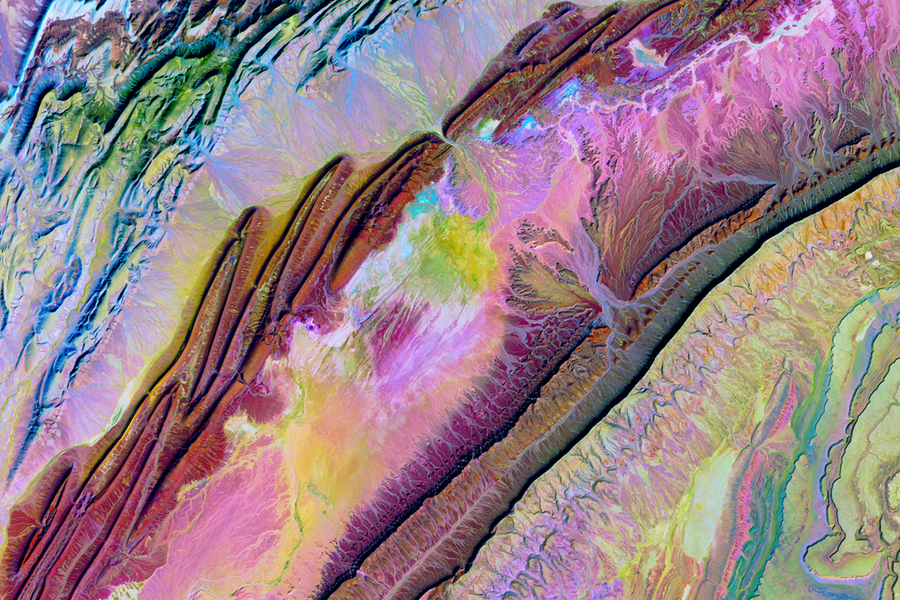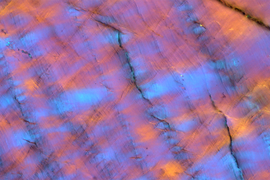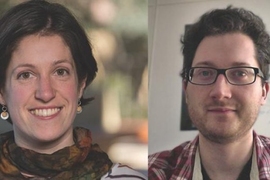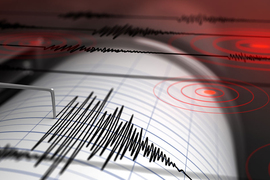Major environmental events write their own headlines. With loss of life and crippling infrastructure damage, the aftershocks of earthquakes reverberate around the world — not only as seismic waves, but also in the photos and news stories that follow a major seismic event. So, it is no wonder that both scientists and the public are keen to understand the dynamics of faults and their hazard potential, with the ultimate goal of prediction.
To do this, William Frank and Camilla Cattania, assistant professors in MIT’s Department of Earth, Atmospheric and Planetary Sciences (EAPS), have teamed up as EQSci@MIT to uncover hidden earthquake behaviors and fault complexity, through observation, statistics, and modeling. Together, their complementary avenues of research are helping to expose the fault mechanics underpinning everything from aseismic events, like slow slip actions that occur over periods of hours or months, to large magnitude earthquakes that strike in seconds. They’re also looking at the ways tectonic regions interact with neighboring events to better understand how faults and seismic events evolve — and, in the process, shedding light on how frequently and predictably these events might occur.
“Basically, [we’re] trying to build together a pipeline from observations through modeling to answer the big-picture questions,” says Frank. “When we actually observe something, what does that mean for the big-picture result, in places where we have strong heterogeneity and lots of earthquake activity?”
Observing Earth as it creeps
While there are many ways to investigate different types of earthquakes and faults, Frank takes a detailed and steady approach: looking at slow-moving, low wave frequency earthquakes — called slow slip — in subduction zones over long periods of time. These events tend to go unnoticed by the public and lack an obvious seismic wave signature that would be registered by seismometers. However, they play a significant role in tectonic buildup and release of energy. “When we start to look at the size of these slow slip events, we realize that they are just as big as earthquakes,” says Frank.
His group leverages geodetic data, like GPS, to monitor how the ground moves on and near a fault to reveal what’s happening along the plate interface as you descend deeper underground. In the crust, near the surface, the plates tend to be locked together along the boundary, building up pressure and then releasing it as a giant earthquake. However, below that region, Frank says, the rocks are more elastic and can deform and creep, which can be picked up on instrumentation. “There are events that are transient. They happen over a set period of time, just like an earthquake, but instead of several seconds to minutes, they last several days to months,” he says.
Since slow slip has the capacity to cause energy loading in subduction zones through both stress and release, Frank and his group want to understand how slow earthquakes interact with seismic regions, where there’s potential for a large earthquake. By digging into observational data, from long-term readings to those taken on the scale of a few hours, Frank has learned that often there are many tiny earthquakes that repeat during slow slip. While a first glance at the data may look like just noise, clear signals emerge on closer inspection that reveal a lot about the subsurface plate interface — like the presence of trapped fluid, and how subduction zones behave at different locations along a fault.
“If we really want to understand where and when and how we're going to have a big earthquake, you have to understand what's happening around it,” says Frank, who has projects spread out around the globe, investigating subducting plate boundaries from Japan to the Pacific Northwest, and all the way to Antarctica.
Modeling complexity
Camilla Cattania’s work provides a counterpoint for Frank’s. Where the Frank group incorporates seismic and geodetic record collection, Cattania employs numerical, analytical, and statistical tools to understand the physics of earthquakes. Through modeling, her team can test hypotheses and then look for corroborating evidence in the field, or vice versa, using collected data to inform and refine models. Influenced by major seismic hazards in her home country of Italy, Cattania is keenly interested in the potential to contribute models for practical use in earthquake forecasting.
One aspect of her work has been to reconcile theoretical models with the complex reality of fault geometry. Each fault has its own physical characteristics that affect its behavior and can evolve over time — not just the dimensions of the fault, but also factors like the orientation of the rock fractures, the elastic properties of the rocks, and the irregularity and roughness of their surfaces. When looking into numerical models of aftershock sequences, she was able to show that they weren’t as predictive as statistical models because previous models were using idealized fault planes in the calculations.
To remedy this, Cattania explored ways to incorporate fault geometry that's more consistent with the complexity found in nature. “We were the first to implement this in a systematic way and then compare it to statistical models, and … to show that these physical models can do well, if you make them realistic enough,” she says.
Cattania has also been looking into modeling how the physical properties of faults control the frequency and size of earthquakes — a key question in understanding the hazards they pose. Some earthquake sequences tend to recur at intervals, but most don’t, defying easy prediction. In trying to understand why this is, Cattania explains, size is everything. “It turns out that periodicity is a property which depends on the size of the earthquake. It's much more unlikely to get periodic behavior for a large earthquake than it is for a small one, and it just comes out of the fundamental physics of how friction and elasticity control the cycle,” she says.
A synergistic approach
Ultimately, through their collaboration in EAPS at MIT, Frank and Cattania are trying to build more communication between observation and modeling in order to foster more rapid advancements in earthquake science. “Ever-improving seismic and geodetic measurements, together with new data analysis techniques, are providing unprecedented opportunities to probe fault behavior,” says Cattania. “With numerical models and theory, we try to explain why faults slip the way they do, and the best way to make progress is for modelers and observationalists to talk to each other.”
“What I really like about observational geophysics, and for my science to be useful, is collaborating and interacting with many different people,” says Frank. “Part of that is bringing together the different observational approaches and the constraints that we can generate, and [then] communicating our results to the modelers. More often than not, there's not as much communication as we'd like [between the groups]; so I’m super excited about Camilla being here.”











